7 November 2017 | Do-It-Yourself, Energy, Video |
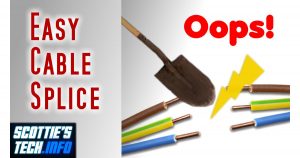 If you’ve ever accidentally chopped through a wire or electrical cable, you know how much fun it can be to try to repair it so that it stays waterproof, dust proof, weatherproof, etc.
If you’ve ever accidentally chopped through a wire or electrical cable, you know how much fun it can be to try to repair it so that it stays waterproof, dust proof, weatherproof, etc.
I recently had just such a fun experience myself. It turns out that there are quite a few nice products out there to make the splicing process WAAAAY easier.
Keep in mind that the type of splice you use depends greatly on the application – and even the type of wire (solid vs stranded).
A wire splice for an automotive-type application must be pretty strong, because vibration is obviously an issue.
An underground electrical cable doesn’t have to withstand vibration, but it definitely needs to be waterproof!
(more…)
5 September 2017 | Energy, How Does it Work?, Video |
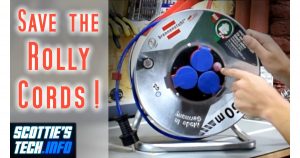 Extension cord reels, or rolly cords as I like to call them, are seriously handy.
Extension cord reels, or rolly cords as I like to call them, are seriously handy.
Nobody likes spending 30 minutes untangling a 50m extension cord.
Trouble is, usually we use them incorrectly!
It turns out you have to read the fine print: You can only use the full capacity of the reel if you fully unwind the rolly cord.
Oops!
(more…)
29 August 2017 | Do-It-Yourself, Energy, Video |
 First, remain calm. Second, watch this video!
First, remain calm. Second, watch this video!
A tripping circuit breaker or GFCI/RCD/differential breaker can be really annoying. It normally doesn’t happen.
When it does, the end result can be that you run around the room with your undies on your head, screaming like a wildperson.
Obviously, if your vacuum cleaner is charred and black and there’s a funny smell in the room, you’ve just figured out why the breaker tripped. But usually, the problem is a bit more subtle than that…
It turns out that with a bit of work, you can often cleverly narrow down the problem to one gizmo and save yourself some money – without setting anything on fire!
Yay!
(more…)
7 August 2017 | EEK!, Energy, Video |
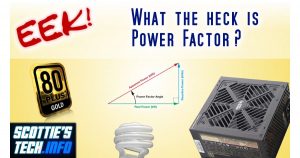 Power factor is one of those things that sounds really complicated, but it’s pretty simple when you boil it down. And every now and then, knowing a little something about power factor comes in handy.
Power factor is one of those things that sounds really complicated, but it’s pretty simple when you boil it down. And every now and then, knowing a little something about power factor comes in handy.
In short, power factor is the ratio of the real power consumed by a gizmo to the apparent power needed to be generated and delivered by the power company.
The reason for this “extra power” from the power company is the inductance and capacitance in your gizmo that results in shifting the AC current sine wave away from being perfectly in sync with the voltage sine wave.
You don’t really need to understand how all that works; just watch the vid to see why it matters!
(more…)
24 June 2017 | EEK!, Energy, How Does it Work?, Video |
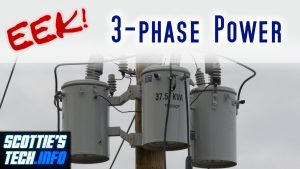 Why does AC electrical power come in 3 phases? What the heck is a “phase”, anyway?
Why does AC electrical power come in 3 phases? What the heck is a “phase”, anyway?
In this episode of the EEK! Series, you’ll learn about 3-phase power and its advantages.
In short: fewer wires, more power, and the Earth itself is a conductor.
In addition, 3-phase industrial motors are more efficient and don’t require a starting capacitor since the 3 phases are “rotating” already.
Be sure to watch EEK! #1 and EEK! #2 first!
(more…)
4 June 2017 | EEK!, Energy, How Does it Work?, Video |
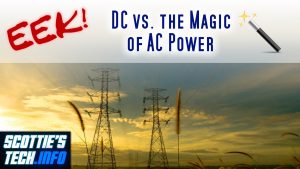 In episode 2 of the EEK! series, we cover the basic difference between direct current (DC) and alternating current (AC). Why is your home powered by AC, and not DC?
In episode 2 of the EEK! series, we cover the basic difference between direct current (DC) and alternating current (AC). Why is your home powered by AC, and not DC?
Simply put, AC allows the use of transformers to step up the voltage, step down the current, and therefore bypass the little problem of too much current flowing over a thin wire.
DC cannot be easily converted in this way for efficient power transmission over long distances. There’s more to say about AC, so look for a 3-phase video soon.
Check out the video below!
(more…)
31 May 2017 | Energy, Gizmos, Video |
 Solar USB chargers are all the rage these days.
Solar USB chargers are all the rage these days.
The most popular models are small, and many have integrated lithium-ion batteries.
But just how good are these things? Will you be happy with a small one, or is it better to supersize it?
In short, get a big one! Smaller solar panels just don’t output enough current to make them really worth the price.
(more…)
9 December 2012 | Energy, Gizmos, How Does it Work? |
 These days, it’s all about energy efficiency.
These days, it’s all about energy efficiency.
In some countries, you can hardly even buy normal incandescent light bulbs any more. You are left with a choice of slightly more efficient “a bulb inside a bulb” halogen options, or compact fluorescent light (CFL) bulbs.
Well, there are some problems with CFL bulbs, as we shall see.
Now, LED bulbs have made their big debut on the scene. They use even less power than CFLs, and supposedly they are better for the environment and all that jazz.
In some ways, this is true – but at a cost unless you are careful about which LED bulbs you pick.
And, since LED bulbs are so darn expensive, you need to choose wisely. Here’s how…
(more…)
8 January 2012 | Computers, Energy, Spare Me! |
 I hate to say, “I told you so!”, but: I told you so!
I hate to say, “I told you so!”, but: I told you so!
Actually, I don’t hate saying it. I’m relishing every second of this glorious moment, and I’m not ashamed to admit it.
Okay, I was ashamed for the few seconds it took me type the first sentence, but I got over it.
What the heck am I yammering about? Green hard drives, of course! You may recall a previous post I wrote:
Recently, Seagate came out and openly called “BS!” on their own green hard drive BS.
I suppose we should praise them for this, but it would have been better if they hadn’t let their marketing bozos direct their engineering department in the first place!
(more…)
12 April 2011 | Computers, Energy, Spare Me! |
 These days, the fad is GREEN. Everything is “eco-this” or “green that”. Of course, we’re supposed to be terribly concerned about saving Mother Earth. Well, I’ve got news for you: Mother Earth is plenty capable of taking care of herself… Whether or not humankind survives her care is another question entirely. Frankly, if I were Big Mama, I’d be pretty pissed off that my occupants were continually dumping toxic crap on me and irradiating me. I don’t think I would care if they were using a certain type of hard drive or not.
These days, the fad is GREEN. Everything is “eco-this” or “green that”. Of course, we’re supposed to be terribly concerned about saving Mother Earth. Well, I’ve got news for you: Mother Earth is plenty capable of taking care of herself… Whether or not humankind survives her care is another question entirely. Frankly, if I were Big Mama, I’d be pretty pissed off that my occupants were continually dumping toxic crap on me and irradiating me. I don’t think I would care if they were using a certain type of hard drive or not.
But, I digress…
If you’re in the market for a new hard drive, you may have noticed that there are now tons of “green” hard drives out there. There are several reasons why you do NOT want one of these things. Perhaps the most important reason is that when you get right down to it, they do almost nothing to truly save energy – which kind of defeats the purpose of having a green drive, now doesn’t it?
(more…)
 If you’ve ever accidentally chopped through a wire or electrical cable, you know how much fun it can be to try to repair it so that it stays waterproof, dust proof, weatherproof, etc.
If you’ve ever accidentally chopped through a wire or electrical cable, you know how much fun it can be to try to repair it so that it stays waterproof, dust proof, weatherproof, etc.






 These days, it’s all about energy efficiency.
These days, it’s all about energy efficiency.


Recent Comments